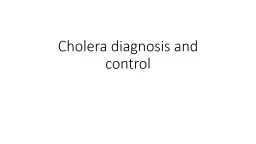

DIAGNOSTIC LABORATORY TESTS a Specimens specimens from culture consist of mucus flecks from stool b Smears Dark field or phase contrast microscopy may show the rapidly motile vibrios ID: 910667
Download Presentation The PPT/PDF document "Cholera diagnosis and control" is the property of its rightful owner. Permission is granted to download and print the materials on this web site for personal, non-commercial use only, and to display it on your personal computer provided you do not modify the materials and that you retain all copyright notices contained in the materials. By downloading content from our website, you accept the terms of this agreement.
Slide1
Cholera diagnosis and control
Slide2DIAGNOSTIC LABORATORY TESTS
a) Specimens:- specimens from culture consist of mucus flecks from stool.
b) Smears:- Dark field or phase contrast microscopy may show the rapidly motile vibrios.
c) Culture:- growth is rapid in peptone agar , on blood agar with a pH near 9.0 or on TCBS agar, and typical colonies can be picked in 18 hours. For enrichment , a few drops of stool can be incubated for 6-8 hours in TAUROCHOLATEPEPTONE BROTH(pH 8.0-9.0) ; organisms from this culture can be stained or subcultured.Transport media: alkaline peptone water, sea water etc
Slide3SLIDE AGGLUTINATION
Agglutination tests for
V. cholerae somatic O antigens may be carried out in a petri dish or on a clean glass slide.
Emulsify the growth in a small drop of saline and mix thoroughly by tilting back and forth for about 30 seconds. Mix the anti O serum and look for agglutination.
Slide4Figure Antisera to the O1 serogroup of
V. cholerae will agglutinate homologous organisms (left). A normal serum or saline control (right) does not show agglutination .
Slide5OXIDASE TEST
Conduct the oxidase test with fresh growth from an HIA slant or any non-carbohydrate-containing medium.
Place 2 to 3 drops of oxidase reagent (1% tetramethyl-p- phenylenediamine ) on a piece of filter paper in a petri dish. Smear the culture across the wet paper with a platinum (not nichrome ) loop, a sterile wooden applicator stick, or toothpick. In a positive reaction, the bacterial growth becomes dark purple within 10 seconds Color development after 10 seconds should be disregarded. Positive and negative controls should be tested at the same time.
Slide6A positive oxidase test (as shown here) results in the development of a dark purple color within 10 seconds.
V. cholerae is oxidase-positive, which differentiates it from oxidase-negative organisms .
Slide7Voges-Proskauer test
The Voges-Proskauer test has been used to differentiate between the El Tor and classical biotype of
V. cholerae O1. Classical biotypes usually give negative results; El Tor isolates are generally positive.
V. cholerae produces acetoin, which is detected in the
Voges-Proskauer
test, giving a red (positive) reaction (left). A negative reaction is on the right.
Slide8HEMOLYSIS TESTING
the classical and El Tor biotypes were differentiated by the ability of the El Tor group to lyse erythrocytes.
However, by 1972 almost all isolates worldwide were nonhemolytic.
The two exceptions to this trend have been the U.S. Gulf Coast and the Australia clones of V. cholerae O1, which are strongly hemolytic when assayed by either the plate or tube hemolysis assay (For this reason, hemolysis continues to be a useful phenotypic characteristic for differentiating the Gulf Coast and Australia clones of V cholerae O1 from El Tor strains from the rest of the world, including Latin America.
Slide9Tube hemolysis, shown in the tube on the left, is demonstrated by the absence of a “button” of sedimented cells and the presence of free hemoglobin in the tube.
Slide10EPIDEMIOLOGY
Six pandemic of cholera occurred between 1857 and 1923, caused mostly by V.
cholerae 01
of the classic biotype and largely originating in ASIA, usually the INDIAN subcontinent. Seventh pandemic began in the CELEBES ISLAND.Starting in 1991,the seventh pandemic (El Tor biotype) spread to PARIS and then to other countries of SOUTH AMERICA and CENTRAL AMERICA . Millions of people have had cholera in this pandemic . Some consider the cholera caused by the serotype
O 139
strain to be the eight pandemic that begin in the INDIAN SUCONTINENT in the 1992-1993, which spread to ASIA .
Cholera is endemic in INDIA and SOUTHEAST ASIA. From these centers ,it is carried along shipping lane ,trade routes and pilgrim migration routes.
Slide11The disease is spread by contact involving individuals with mild or early illness and by water, food and flies.
V.cholerae
lives in the aquatic environments and such environments are the vibrios natural reservoir.
It can survive for year and grow , but when conditions are not suitable for growth it can become dormant.
Slide12TREATMENT
Therapy consist of water and electrolyte replacement to correct the severe dehydration and salt depletion.
Oral tetracycline tends to reduces stool output in cholera and shortens the period of excretion of vibrios. In some endemic areas , tetracycline resistant of V.cholerae has emerged , due to the transmissible plasmids.
Slide13In Kadoma, a child brought in a cart to an MSF
cholera
treatment center .
Ciprofloxacin can also be used 500 mg every 12 hours for 3 days or erythromycin at 500 mg every 6 hours for 3 days is also effective
Slide14CONTROL
Control rests on education and on improvement of sanitation particularly of food and water.
Patients should be isolated .
Repeated injections of a vaccine containing either lipopolysaccharides extracted from vibrios or dense vibrio suspension can confer limited protection to limited healthy exposed persons but not effective in epidemic control.